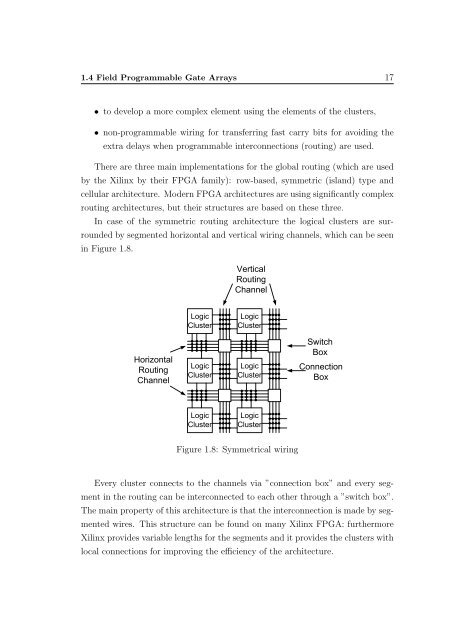PPKE ITK PhD and MPhil Thesis Classes
PPKE ITK PhD and MPhil Thesis Classes
PPKE ITK PhD and MPhil Thesis Classes
Create successful ePaper yourself
Turn your PDF publications into a flip-book with our unique Google optimized e-Paper software.
1.4 Field Programmable Gate Arrays 17<br />
• to develop a more complex element using the elements of the clusters,<br />
• non-programmable wiring for transferring fast carry bits for avoiding the<br />
extra delays when programmable interconnections (routing) are used.<br />
There are three main implementations for the global routing (which are used<br />
by the Xilinx by their FPGA family): row-based, symmetric (isl<strong>and</strong>) type <strong>and</strong><br />
cellular architecture. Modern FPGA architectures are using significantly complex<br />
routing architectures, but their structures are based on these three.<br />
In case of the symmetric routing architecture the logical clusters are surrounded<br />
by segmented horizontal <strong>and</strong> vertical wiring channels, which can be seen<br />
in Figure 1.8.<br />
Figure 1.8: Symmetrical wiring<br />
Every cluster connects to the channels via ”connection box” <strong>and</strong> every segment<br />
in the routing can be interconnected to each other through a ”switch box”.<br />
The main property of this architecture is that the interconnection is made by segmented<br />
wires. This structure can be found on many Xilinx FPGA: furthermore<br />
Xilinx provides variable lengths for the segments <strong>and</strong> it provides the clusters with<br />
local connections for improving the efficiency of the architecture.






![optika tervezés [Kompatibilitási mód] - Ez itt...](https://img.yumpu.com/45881475/1/190x146/optika-tervezacs-kompatibilitasi-mad-ez-itt.jpg?quality=85)









